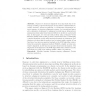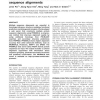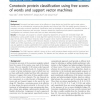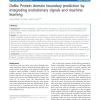67 search results - page 3 / 14 » Predicting and improving the protein sequence alignment qual... |
RECOMB
2007
Springer
14 years 5 months ago
2007
Springer
Abstract. Sequence to structure alignment is an important step in homology modeling of protein structures. Incorporation of features like secondary structure, solvent accessibility...
NAR
2007
13 years 4 months ago
2007
Multiple sequence alignments are essential in homology inference, structure modeling, functional prediction and phylogenetic analysis. We developed a web server that constructs mu...
BMCBI
2011
12 years 8 months ago
2011
Background: Conotoxin has been proven to be effective in drug design and could be used to treat various disorders such as schizophrenia, neuromuscular disorders and chronic pain. ...
BMCBI
2008
13 years 5 months ago
2008
Background: Protein remote homology detection and fold recognition are central problems in bioinformatics. Currently, discriminative methods based on support vector machine (SVM) ...
BMCBI
2011
12 years 12 months ago
2011
Background: Accurate identification of protein domain boundaries is useful for protein structure determination and prediction. However, predicting protein domain boundaries from a...




